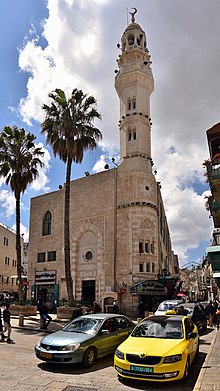
Summary
The Mosque of Omar (Arabic: مسجد عمر Masjid Umar) is the only mosque in the Old City of Bethlehem,[1][2] Palestine. It is located on the west side of Manger Square, across the square from the Church of the Nativity.
| Mosque of Omar | |
|---|---|
مسجد عمر | |
 | |
| Religion | |
| Affiliation | Islam |
| Location | |
| Location | Bethlehem, Palestine |
 Shown within the West Bank | |
| Geographic coordinates | 31°42′16.34″N 35°12′20.03″E / 31.7045389°N 35.2055639°E |
| Architecture | |
| Type | mosque |
| Completed | 1860 |
| Minaret(s) | 1 |
History edit
Early Muslim period; location edit
The mosque is named after Omar (Umar) ibn al-Khattab (c. 581–644), the second Rashidun Caliph. Having conquered Jerusalem, Omar had travelled to Bethlehem in 637 CE to issue a law that would guarantee respect for the shrine and safety of Christians and clergy.[3][dubious ] Only four years after the death of the Islamic prophet Muhammad, Omar allegedly prayed at the location of the mosque.[4][dubious ]
Yaqut al-Hamawi (d. 1229) relates how Caliph Omar was advised by a Christian monk to build a mosque in an arcaded building or haniyya, rather than transform the Church of the Nativity into a mosque.[5] Yaqut places the haniyya at a site where biblical kings David and Solomon were thought to be buried.[5] In the early 10th century, Eutychius of Alexandria (877–940) describes the haniyya as placed within a Christian site, facing south and thus being appropriate for Muslim prayer (qibla), and mentions Omar as allowing Muslims to pray in the haniyya only one at a time; and prohibiting them to touch anything there, as well as to call for or conduct congregational prayers inside.[5] Eutychius complained that in his time, the early 10th century, Muslims had broken these three rules.[5] The evolution of the status of this site of prayer seems to have been from an arcaded space attached to a Christian building, where at first Muslims held only limited rights for performing prayers, to a congregational mosque starting from the early tenth century.[5]
The exact location of the haniyya is not clear, but the place thought during late antiquity to be the burial site of David and Solomon was described by the Pilgrim of Bordeaux (330) as not far from the Basilica of the Nativity, and by the Piacenza Pilgrim (570) as half a Roman mile from the town centre.[5]
Modern mosque at new location (1860) edit
The current mosque was built in 1860,[4] on land given for the purpose by Jerusalem's Greek Orthodox Church.[2] It was renovated in 1955 during Jordanian control of the city.[3] In the past, before the advent of light bulbs, it was common for Muslims and Christians in Bethlehem to offer olive oil to light up the surroundings of the mosque, which was evidence of religious coexistence in the city.[3]
Tensions (2000s) edit
On February 20, 2006, the Dalai Lama canceled his visit to the mosque, among other places, due to pressure from the government of China. The Palestinian National Authority had requested the cancellation. A foreign ministry official, Majdi al-Khaldi, told reporters,
At the request of the Chinese government, we have not received or dealt with him given his separatist ambitions for Tibet.... Given our friendly relations with the Chinese government, which supports the Palestinian people, we asked the local (Bethlehem) authorities as well as civil society groups not to receive him and they acquiesced with our request.[6][7]
In February 2007, Israel's Shin Bet security agency arrested 20 men who were allegedly recruited for a "Hamas-linked cell" by a Muslim cleric in the Mosque of Omar.[8] Nevertheless, the mosque remained peaceful when Palestinian President Mahmoud Abbas visited on Christmas Eve 2007.[9]
Gallery edit
References edit
- ^ Valentine Low & Catherine Philp (24 January 2020). "Prince Charles offers strong message of support for Palestinians in Bethlehem". The Times. Retrieved 24 September 2020.
- ^ a b "Mosque of Omar: Mosque in Bethlehem". Lonely Planet. Retrieved 24 September 2020.
- ^ a b c Mosque of Omar GeoCities: Bethlehem Homepage
- ^ a b "Mosque of Omar (Bethlehem)". Atlas Travels and Tourism Agency. Archived from the original on July 29, 2013. Retrieved January 20, 2008.
- ^ a b c d e f Mattia Guidetti (2016). In the Shadow of the Church: The Building of Mosques in Early Medieval Syria. Arts and Archaeology of the Islamic World (Book 8). BRILL; Lam edition. pp. 30–31. ISBN 9789004325708. Retrieved 2018-04-09.
- ^ "Palestinians refuse Dalai Lama visit again". Archived from the original on March 2, 2007.
- ^ "Dalai Lama visit". Middle East Times. House and Land Rights Network. 20 February 2006.[dead link]
- ^ "Israel nabs 20 terror suspects". UPI. February 5, 2007.
- ^ "Peace talks spark tourist influx into Bethlehem". CBC News. Associated Press. December 24, 2007.
External links edit
- Photos of the Mosque of Omar at the Manar al-Athar photo archive


